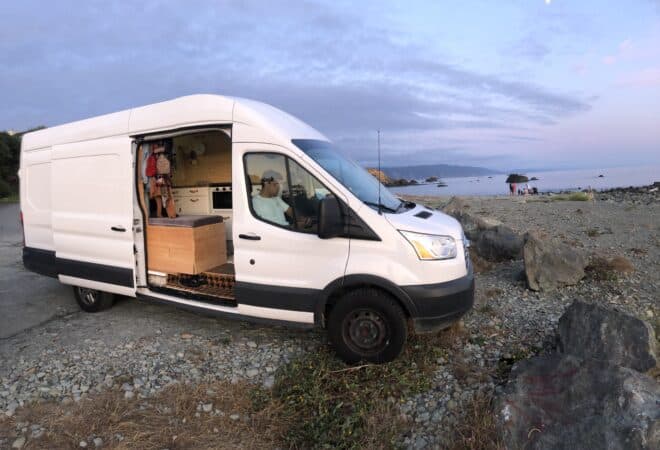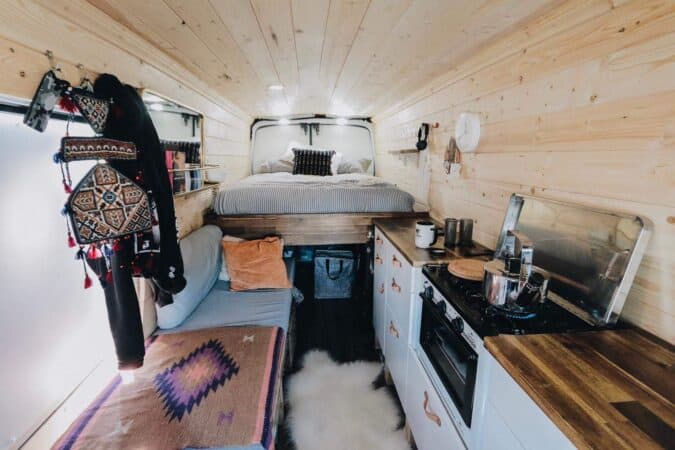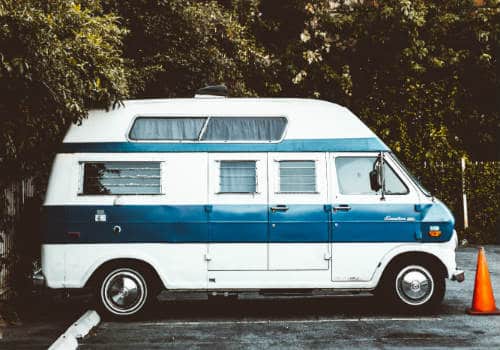Planning to go on an adventure this weekend? Before you invest your money in a brand new RV or fully-furnished trailer, you might get more out of the experience if you fix up your own van. I converted my trusty five-year-old cargo van into a comfy camper van within a week. If you want to know how I did it, read on!
The Fun in Converting Your Own Camper Van
If you feel the lust for camping and adventure but don’t have the budget of several thousand dollars, converting your own van into a camper van is a great option. You can convert an old van that you already own, or buy a new or used model for a low price. In any case, you’ll get most of the fun and comfort of a full camper with less of the budget strain. It’s also fun to basically customize your camper into a completely unique and personal space.
How to Convert a Van into a Camper Van
It’s easy to feel intimidated by the prospect of converting a van into a camper van. After all, what do we really know about construction or automobile engineering? Luckily, it doesn’t really take a lot of expertise to get your adventure going. As long as you have the desire to get things done, I promise you can have a functional camper in the blink of an eye.
There are several significant steps to converting a camper van. I’ve divided it into four sections:
- Preparing the body of the van
- Measuring and planning the camper
- Building the essentials
- Furnishing and finishing
At the end of this hassle-free guide, I’ll also give a quick rundown of how much it cost me to build my camper van from my old car. If you’re planning to buy a new van or to add more features to your camper, you’ll definitely run-up to a bigger price tag.
#1 – Step One: Prepare the Body of the Van

It goes without saying that you can’t have a camper van without a van as your main body. If you’re lucky, you already have a van gathering dust in your garage. If you’re planning to buy a van, be smart! I’ve talked about how important it is to search for the right fit when it comes to purchasing and negotiating for trailers; the same is definitely true for your van.
To get started with your camper van, you need a budget and a general idea of what you want. Narrow down your many options concerning the car make and model. Once you have a list of the cars you want, you can battle based on price, service options, and availability in your region.
Aside from looking at the nearest dealerships and car shops in your area, you have several other options. You can get pretty good deals in shops across the state, or even in the next state because some shops charge differently depending on freight costs. Another choice is to go look for a used van from friends and family. If you have a rare or vintage van model in mind, you can try your chances on trading groups online or even Craigslist.
If you do decide on getting a used car instead, you have to balance out the cost savings against the value of the van you’re getting. Here are some of the parts you need to check.
- Tires and treads
- Air conditioning system, windows, and overall ventilation
- Clearance (how far the van is from the ground)
- Engine noise and function
- Brake system
- Leaks
If it’s not in good condition, you’re better off buying a new van, even with a less attractive model. The last thing you want is to get stranded or feel overheated when you’re already out camping. You also don’t want a cheap camper van that keeps bumping and scratching on the ground, especially when you go off-road.
Some final things to consider when getting your van: wheel drive and mileage.
The capability of your van during the more difficult winter months depends on whether or not you get a rear-wheel drive or a four-wheel drive. Then again, you might not be the type to go camping during winter.
While you’re unlikely to get high gas mileage for a camper van (if you do, please share your secrets below!), it’s still important to get a good idea of how many miles you can get per gallon, especially if the budget is tight. Gasoline costs can really add up quickly if you’re not careful.
After getting a new or used van, the next step in preparation is to gut its insides and clean it out completely. Take a day to unbolt any accessories you won’t need, like the wheelchair lift or built-in containers. We spent another half-day cleaning the van, starting from the admittedly dirty carpet to some of the stains. I went to town with a vacuum and brush to really get the grime out. If you’re working with a used car, you’ll want to devote more time and effort to freshen up the interiors.
Once you have your van emptied and cleaned, you have a working canvas for your future camper van.
#2 – Step Two: Measure and Plan the Camper

When you have complete control over the design and build of your camper van, your options are practically limitless. You can opt for a fully equipped van that can act as a second home with a generator for electricity and space for a kitchen, and basically, join the van life movement. I know some people who spent the time to learn and build in a skylight onto their camper van.
Honestly, I had much simpler plans. Back when I first converted my van to a camper, I was only thinking of getting a bed and some space for storage out in the woods. I was planning for a smaller home away from home. In addition, a primary consideration was the budget. I thought I’d rather save for a future pre-made RV than spend all out for bells and whistles in a homemade camper.
You can get a lot of inspiration online and from your community. I’ve seen a lot of DIY camper vans with a unique design theme, a raised roof, and a complete kitchen. Your plans for your camper depend entirely on what you need and also on the size of your van.
10 Ford Transit Van Conversions With Video Walk-Throughs
Part of the planning process is attention to detail. First of all, you need to measure every part of your van. Aside from the length, height and width dimensions of your interiors and exteriors, you also need to measure the windows and the wheel wells.
Imagine you’re an architect and you need to create an accurate drawing of your van’s floor plan. Be careful because many vans don’t come as conveniently straight-angled rectangles. The center or the floor can bow out slightly, and the trunk area may be differently shaped.
Once you have an image of what kind of camper van you want, and you have the measurements of your car, you can get started with your general layout. In my experience, these are the parts which are an absolute must for any camper:
- Full-size bed
- Working kitchen with sink
- Storage for personal and camping gear
- Multi-purpose desk or surface
You need to plan for a pet if you have one, or for an extra resting space if you’re planning to camp with someone else. Once you have your priorities in place, you can sketch out your plan on paper. Think about the natural flow of your camper van. What part goes where?
There are several companies that sell conversion kits to help DIY campers. These conversion kits usually include comprehensive guides as well as the necessary materials for insulation, paneling, lighting, and other essential features. However, following these kits can add more strain to your budget. You can still do steps three and four on your own.
# 3 – Step Three: Build the Essentials
It’s time to get your hands dirty! Trust me, building all the camper essentials from scratch material is 100% possible as long as you have a good plan in mind.
The first priority of any camper is the bed. Most people I know use 2×4’s and 2×6’s plywood to create the bed platform. For a full afternoon, we built a bed frame that would fit our interior measurements precisely. I didn’t bother with a header or an intricate border. If you’re not very handy with woodwork, you might spend the full day, especially if you add drawer space underneath one side of the bed frame like what we did.
I also made most of the kitchen counter using wooden boards, with enough space for a mobile stove, a functional sink, and food preparation space. We made sure to add a drain stopper to our sink. A simple countertop is more than enough. If you make a simple hollow flat desk, you can have a lot of storage space underneath. You just need to be neat about stacking your things. You can also add drawer doors or rig up a curtain under the counter, though that will increase your cost and time spent.
What Are the Other Essentials You Need to Consider?
- Electricity – If you’re planning to install a generator into your camper van, then you should be prepared to spend more money and time. An alternative would be to carry an external battery pack to charge your electronics, or to buy a power inverter to fast charger your gadgets. If you’re really up to investing in your camper van, you can install solar panels.
- Lights – Because we decided on non-permanent electronics and lighting, we outfitted the camper van with battery-powered push lights. They won’t last forever, but getting a good brand will give you several months of lighting anyway. Another good option is investing in solar-powered lanterns. You can charge them up during the day near the windows, and then use them as needed.
- Ventilation – Camping inside can be a nightmare in the summer without the right ventilation. We mostly slept with the doors open and with dependable fans on hand. We had a small handheld rechargeable fan for personal use and as a backup, as well as a larger USB fan that aired out the whole space.
- Insulation – Insulation can be as simple as adding thin reflective coating (like Reflectix) to guard windows against radiant heat, or a bit more complicated with foam board insulation like Expanded Polystyrene. I never really traveled with the DIY camper van during winter; just keep in mind that insulation will probably increase your costs because you need non-toxic material that can resist moisture and mold while keeping the cold out.
#4 – Step Four: Furnish and Finish Your Camper Van
There are many ways you can personalize your van. We were aiming for a simpler experience, so we didn’t spend a lot of money on fairy lights or fancy curtains. We sewed curtains to fit our camper van windows –an easy, but a more expensive alternative is to buy ready-made short curtains and just fold-stitch to shorten the edges.
The little details are easy to miss out on when you start long-term camping. What about laundry? We dedicated a small space under the kitchen counter for our laundry detergent and dish soap. For drying, we built a makeshift clothesline using some rope and clothespins. For the bed sheets and bigger fabrics, we had to go to the laundromat or get them washed at the house. Trash is also something people don’t usually think about, so make sure to buy a trash can with a lid!
While they’re not in the laundry or sink, our clothes and other belongings were stored in the handy plastic bins you can find in any home store. We also made full use of packing cube to keep the fabrics compressed and organized.
The rest of the furnishing process depends on your tastes and your idea of a good camping trip. If you’re all for the #VanLife, then you’ll probably want to design your space with personal items and even some art. You’ll also have to store camping essentials such as outdoor chairs, a large cooler, durable cutlery, pots, and propane.
Get creative! There are lots of spaces you can use to make your camper van as comfortable and equipped as possible. Use the vertical space, the back of the seats, the area underneath the bed, and so on. Adding an area for green things or art will make your camper feel more personalized and alive.
The Cost of Converting a Van to a Camper Van

If you’re like me and you’ve conveniently owned a good, sturdy van for several years, you can take off a couple thousand dollars from this estimation. The list below is an estimate of the cost for those who need to buy all the DIY materials.
- Used van / $2000 – for a good-sized camper van that’s over two decades old, you can get a great deal for only a couple thousand bucks, with some change for title transfers and accessories
- Cleaning materials / $10 – assuming you don’t have a deep-cleaning solution and a strong car air freshener, you’ll have to spend a bit on cleaning supplies.
- Plywood / $50 – you can more or less get all the 2×4 and 2×6 plywood you need for $50 bucks
- Full mattress / $250 – depending on how luxurious you want to go, a mattress can run up from $60 (very thin and basic) to more than $400. A classic short queen mattress can be around $200, depending on where you shop.
- Kitchen appliances / $100 – you can get a functional stove and a simple trailer kitchen sink for under $60. Adding in some knives, a cutting board, and a set of dishware, your total for the kitchen would run under a hundred bucks.
- Electronic chargers and inverters / $50
- DIY curtains / $30
- Camping chairs, large cooler, Coleman propane, and other camping equipment / $100 – you probably already have these essentials at home, but if you want to buy new equipment and tools for your DIY camper van, you’ll have to spend around another hundred bucks.
The bare-bones total runs up to approximately $2500. Over time, you’ll probably end up spending closer to $3000 as you buy more things to customize your space. There are plenty of articles online with recommendations on the best and latest camping gear you can buy.
Final Thoughts
Ready to experience the wildlife and fresh air from the comfort of your van? Trust me, going on an outdoor adventure with your favorite camping gear inside your DIY camper van is a truly unique and personal experience.
Are you up to the challenge of converting your van to a camper van? Will you create a simple camper van as we did, or design a more showcase-worthy trailer? Tell me how it went in the comments below!





Your web site has exceptional material. I bookmarked the website.